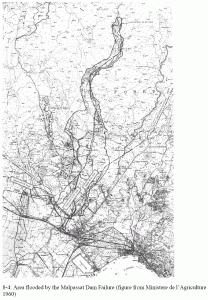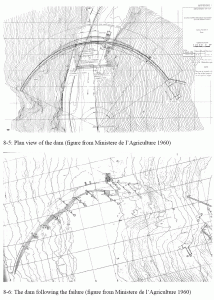The sudden and unexpected collapse of the Malpasset Dam in France let to the considerable loss of life. This case study is discussed in Chapter 8 of the book Beyond Failure: Forensic Case Studies for Civil Engineers, Delatte, Norbert J., ASCE Press.
The Malpasset Dam was a continuation of the work of the famed designer Andr Coyne, who had slowly been raising the allowable compressive stresses within arch dams. At Malpasset, the allowable compressive stress was increased from 2.4 MPa (355 psi) to 4.7 MPa (680 psi). When it was completed, Malpasset was the thinnest arch dam in the world (Ross 1984, p. 127).
At 9:14 p.m. on December 2, 1959, the Malpasset dam failed explosively, giving rise to a flooding wave more than 40 m [130 ft] high. Only a little portion of the arch of the dam still remained in its original position. 421 casualties were reported.
The technical cause of the failure was revealed during the investigations. A thin clay filled seam in the rock behind the left abutment allowed the abutment to shift. This displacement and the loss of support led to the cracking at the center of the dam (Levy and Salvadori 1992, pp. 166-172).
The clay seam was only 25- 50 mm (1-2 inches) wide. The prosecutor, after the failure, alleged that this seam should have been taken into account in the design of the dam.
This case study is covered on pages 166-172 of Levy and Salvadori (1992). The French Ministry of Agriculture Final Report of the Investigating Committee of the Malpasset Dam (Ministere de l’Agriculture 1960) was published in English translation by the U.S. Department of the Interior and the National Science Foundation but may be difficult to find.
Illustrations from Chapter 8 of the book Beyond Failure: Forensic Case Studies for Civil Engineers, Delatte, Norbert J., ASCE Press.







